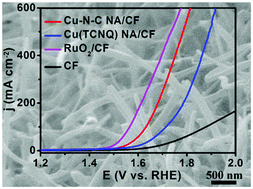当前位置:
X-MOL 学术
›
Inorg. Chem. Front.
›
论文详情
Our official English website, www.x-mol.net, welcomes your
feedback! (Note: you will need to create a separate account there.)
Efficient oxygen evolution electrocatalyzed by a Cu nanoparticle-embedded N-doped carbon nanowire array†
Inorganic Chemistry Frontiers ( IF 6.1 ) Pub Date : 2018-03-20 00:00:00 , DOI: 10.1039/c8qi00119g Xiaojuan Zhu 1, 2, 3, 4, 5 , Xifeng Shi 6, 7, 8, 9, 10 , Abdullah M. Asiri 11, 12, 13, 14, 15 , Yonglan Luo 1, 2, 3, 4, 5 , Xuping Sun 1, 2, 3, 4, 5
Inorganic Chemistry Frontiers ( IF 6.1 ) Pub Date : 2018-03-20 00:00:00 , DOI: 10.1039/c8qi00119g Xiaojuan Zhu 1, 2, 3, 4, 5 , Xifeng Shi 6, 7, 8, 9, 10 , Abdullah M. Asiri 11, 12, 13, 14, 15 , Yonglan Luo 1, 2, 3, 4, 5 , Xuping Sun 1, 2, 3, 4, 5
Affiliation

|
Development of efficient and durable catalysts based on earth-abundant elements for oxygen evolution reactions (OER) is important for renewable energy storage and conversion technologies. Herein, we report the development of a Cu nanoparticle-embedded N-doped carbon nanowire array on copper foam (Cu–N–C NA/CF) via carbonization of a Cu(TCNQ) (TCNQ = 7,7,8,8-tetracyanoquinodimethane) nanoarray. As a 3D OER electrode, this Cu–N–C NA/CF shows high catalytic activity, needing an overpotential of 314 mV to drive a geometrical current density of 20 mA cm−2 in 1.0 M KOH. It also shows strong long-term electrochemical durability. This suggested that CuO nanoparticles as active species were in situ electrochemically converted from Cu nanoparticles and stably dispersed in the carbon matrix during electrocatalysis.
中文翻译:

嵌入Cu纳米粒子的N掺杂碳纳米线阵列电催化的高效放氧†
基于可再生氧的储存和转化技术,开发基于地球丰富元素的高效耐用的催化剂以进行氧气释放反应(OER)至关重要。在这里,我们报告通过碳化铜(TCNQ)(TCNQ = 7,7,8,8-四氰基喹二甲烷)纳米阵列。作为3D OER电极,这种Cu–NC–NA / CF具有高催化活性,需要过电位314 mV才能在1.0 M KOH中驱动20 mA cm -2的几何电流密度。它还显示出强大的长期电化学耐久性。这表明CuO纳米颗粒作为活性物质是原位的 由Cu纳米颗粒电化学转化并在电催化过程中稳定地分散在碳基质中。
更新日期:2018-03-20
中文翻译:

嵌入Cu纳米粒子的N掺杂碳纳米线阵列电催化的高效放氧†
基于可再生氧的储存和转化技术,开发基于地球丰富元素的高效耐用的催化剂以进行氧气释放反应(OER)至关重要。在这里,我们报告通过碳化铜(TCNQ)(TCNQ = 7,7,8,8-四氰基喹二甲烷)纳米阵列。作为3D OER电极,这种Cu–NC–NA / CF具有高催化活性,需要过电位314 mV才能在1.0 M KOH中驱动20 mA cm -2的几何电流密度。它还显示出强大的长期电化学耐久性。这表明CuO纳米颗粒作为活性物质是原位的 由Cu纳米颗粒电化学转化并在电催化过程中稳定地分散在碳基质中。











































 京公网安备 11010802027423号
京公网安备 11010802027423号